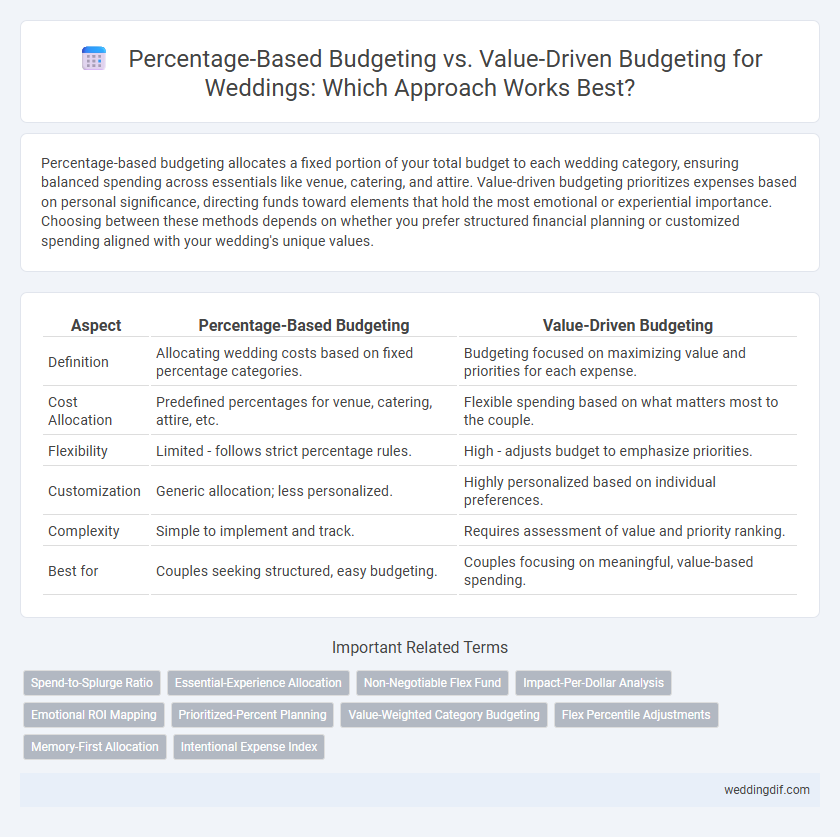Percentage-based budgeting allocates a fixed portion of your total budget to each wedding category, ensuring balanced spending across essentials like venue, catering, and attire. Value-driven budgeting prioritizes expenses based on personal significance, directing funds toward elements that hold the most emotional or experiential importance. Choosing between these methods depends on whether you prefer structured financial planning or customized spending aligned with your wedding's unique values.
Table of Comparison
| Aspect | Percentage-Based Budgeting | Value-Driven Budgeting |
|---|---|---|
| Definition | Allocating wedding costs based on fixed percentage categories. | Budgeting focused on maximizing value and priorities for each expense. |
| Cost Allocation | Predefined percentages for venue, catering, attire, etc. | Flexible spending based on what matters most to the couple. |
| Flexibility | Limited - follows strict percentage rules. | High - adjusts budget to emphasize priorities. |
| Customization | Generic allocation; less personalized. | Highly personalized based on individual preferences. |
| Complexity | Simple to implement and track. | Requires assessment of value and priority ranking. |
| Best for | Couples seeking structured, easy budgeting. | Couples focusing on meaningful, value-based spending. |
Understanding Percentage-Based Budgeting for Weddings
Percentage-based budgeting for weddings allocates specific portions of the total budget to key categories such as venue, catering, attire, and entertainment, often based on recommended industry standards. This method provides a clear financial framework, ensuring balanced spending across all essential elements while preventing overspending in any one area. By adhering to percentage guidelines, couples can maintain control over costs and prioritize elements that align with their vision without exceeding their overall budget.
What Is Value-Driven Wedding Budgeting?
Value-driven wedding budgeting focuses on allocating funds based on the couple's personal priorities and values rather than fixed percentage categories. This method ensures that money is spent on what matters most, such as venue ambiance or culinary experience, creating a more meaningful and customized celebration. Couples using value-driven budgeting often achieve higher satisfaction by aligning expenses directly with their unique vision and emotional significance.
Core Differences Between Percentage-Based and Value-Driven Approaches
Percentage-based budgeting allocates fixed portions of the total wedding budget to predefined categories such as venue, catering, and attire, ensuring a balanced distribution based on average industry standards. Value-driven budgeting prioritizes expenditures based on the couple's personal values and experiences, directing more funds toward elements that hold greater emotional or practical significance, such as a memorable venue or unique entertainment. The core difference lies in the rigid, formulaic allocation of resources versus a flexible, personalized approach that aligns spending with individual priorities rather than preset percentages.
Pros and Cons of Percentage-Based Wedding Budgeting
Percentage-based wedding budgeting allocates fixed portions of the total budget to specific categories, such as allocating 40% for the venue and 20% for catering, which simplifies planning and helps maintain financial discipline. This method provides clear spending limits but can restrict flexibility, especially if priorities shift or unexpected expenses arise. However, it may not account for personal preferences or unique vendor pricing, potentially leading to either overspending or underspending in critical areas.
Advantages and Challenges of Value-Driven Wedding Budgeting
Value-driven wedding budgeting prioritizes spending on elements that hold the most personal significance, ensuring a more meaningful celebration tailored to the couple's unique preferences. This method enhances satisfaction by aligning expenses with core values but requires disciplined evaluation of each cost to avoid overspending on less critical items. Challenges include potential difficulty in quantifying intangible values and the need for rigorous communication between partners to maintain budget clarity and prevent conflicts.
How to Decide Which Wedding Budgeting Method Suits You
Choosing between percentage-based budgeting and value-driven budgeting for weddings depends on prioritizing personal values versus strict financial limits. Percentage-based budgeting allocates fixed portions of the total budget to categories like venue, catering, and attire, offering clear structure ideal for those preferring straightforward guidelines. Value-driven budgeting emphasizes allocating funds according to what matters most, such as experience quality or specific elements, making it suitable for couples seeking personalized financial priorities over rigid percentages.
Common Budgeting Mistakes to Avoid in Wedding Planning
Allocating a fixed percentage of your total wedding budget to specific categories often leads to overspending on less critical elements, while undervaluing key experiences that matter most to you and your guests. Ignoring the true value and priorities behind each expense can cause misaligned spending, resulting in stress and dissatisfaction. Avoiding rigid percentage-based rules and embracing a value-driven approach ensures that funds are strategically assigned to what creates the most lasting impact, such as the venue, food, and entertainment.
Real-Life Examples: Percentage-Based vs Value-Driven Wedding Budgets
Percentage-based budgeting allocates fixed portions of the total wedding budget to categories like venue, catering, and attire, exemplified by spending 40% on venue and 20% on catering. Value-driven budgeting prioritizes expenses based on personal importance, such as investing more in photography or entertainment despite these categories traditionally receiving smaller shares. Real-life cases show couples using percentage-based methods for straightforward planning, while others choose value-driven approaches to reflect unique preferences and enhance overall satisfaction.
Tips for Successfully Implementing Your Chosen Wedding Budget Strategy
Establish clear financial priorities and allocate funds accordingly to align with your wedding vision, whether using Percentage-Based Budgeting or Value-Driven Budgeting. Regularly track expenses against your budget categories and adjust allocations to prevent overspending and ensure key elements receive sufficient funding. Engage all stakeholders in open communication to maintain transparency and avoid unexpected costs throughout the planning process.
Maximizing Your Wedding Experience: Balancing Cost and Personal Values
Percentage-based budgeting allocates funds by dividing the total wedding budget into fixed percentages for categories like venue, catering, and attire, ensuring financial discipline and preventing overspending. Value-driven budgeting prioritizes spending on aspects most meaningful to the couple, such as unique experiences or personalized touches, enhancing emotional satisfaction and guest engagement. Maximizing your wedding experience involves balancing numerical budget constraints with personal values to create a celebration that is both financially sound and deeply memorable.
Percentage-Based Budgeting vs Value-Driven Budgeting for weddings. Infographic

 weddingdif.com
weddingdif.com